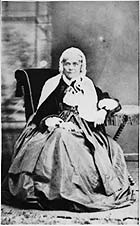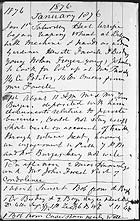Where is Home?
Forming Social Networks

Eliza and William Shaw, Hester and William Tanner and George Fletcher Moore created connections and built relationships with their new environment and this was part of the process of how, in varying degrees, they came to feel a sense of belonging to the Upper Swan. However, they also developed feelings of attachment and belonging by forming relationships with the people around them and by creating a home.
These colonists at the Swan River formed close social networks. In lieu of family support they shared equipment, food and information and they offered one another comfort and companionship. William and Eliza Shaw frequently shared their camp oven they used for baking bread and William Tanner described their neighbourhood as being, 'very populous and we are all very friendly and are constantly visiting and receiving presents, as a lamb, haunch or leg of kangaroo, spareribs, leg of mutton, quarter of kid, etc., besides fresh butter and vegetables.'[5]
Eliza Shaw also valued her friends at the Upper Swan: 'ours is the most friendly neighbourhood you can imagine…I am the richest person in the world possessing the best, the very best of friends in dear Old England, and certainly the most respectable, kind and worthy ones in Western Australia.'[6]

The following month Eliza confirmed the importance of friends when she wrote that if all her friends were with her she 'should not feel one regret at having left England'.[7]
Gardens
Another way of creating a home was to garden. While vegetable and fruit growing was a priority for these early colonists they soon planted flowers as well. This urge to grow flowers has sometimes been understood as another way that the colonists displaced the native flora, but it can also be viewed as a way of making a living connection with a new environment. For example, by the winter of 1832 George Fletcher Moore had planted roses as well as vegetables and fruits. Five years later when his property was more established he invested additional resources in his flower garden. As Moore explained: 'I have a gardener making a little plantation of flowers and shrubs in front of the house…He supplied about twenty geraniums and stocks, and other things'.[8]

Finding Home at the Upper Swan
The word 'home' can carry a range of meanings and although colonists sometimes referred to England or Ireland as 'home' they also developed affection for their houses and properties in the Colony and frequently referred to these places as 'home'. Sometimes, too, they felt confused about where they felt that they belonged. Moore articulated these tensions and turmoils and expressed these in his memoirs: 'How comfortable to be at home - at home! What singular beings we are. What ideas this word suggests. Where is Home?'[9]
Eliza Shaw also developed strong ties to their property, 'Belvoir', but William seemed less able to adjust and rarely expressed contentment. Eliza derived much satisfaction and strength from her children and associated home with them. When her children were scattered from 'Belvoir' and lived at Toodyay and Champion Bay she lamented the distances between herself and her children and grandchildren. She wished they were closer for help and comfort and felt that 'we do indeed seem cut off from everything and everybody near and dear to us, and might as well be buried alive as far as family intercourse goes.'[10]

Eliza's last letters and final diary entry when she was eighty-five years old convey the love she felt for 'Belvoir', and she wrote of this property as though her family had been there for centuries, rather than decades. In the 1870s the financial situation of their property was grim and Eliza was eventually forced to sell it. She expressed her sorrow in her diary: 'Oh! What a trial it will be to see it pass away' and 'Alas, how am I to write that poor dear Belvoir is advertised for sale.'[11] For Eliza, losing 'Belvoir' was like losing a part of herself.
Eliza Shaw's primary attachment was to her nuclear family but William and Hester Tanner felt attached to their extended family, most of whom remained in England. Thus, although they both appreciated aspects of Western Australia, they missed their family and friends too much and they never truly settled here. After only four years in the Colony they returned to England for three years but then departed again for the Swan River. However, largely due to their ongoing homesickness, Hester's ill health and their deteriorating financial situation they left the Colony for the final time in January 1844. William Tanner died in 1845 and Hester one year later in 1846.
George Fletcher Moore connected strongly to the place he frequently called home on the Upper Swan but for him, as for William and Hester Tanner, their primary attachment remained to their place of origin. They returned to England and even after Moore's wife died, with no family and due to his disillusion with the economic state of the Colony, the connections that he had made were not strong enough to draw him back again. So, of the colonists at the Upper Swan discussed here, it was Eliza Shaw who developed the strongest attachments. However, this did not come from a love of the land. It arose from her strong sense that her home was with her children and it gained strength from her longevity in the Colony.
The next part of this series will focus on colonists who settled in the Avon Valley in the 1840s, 50s and 60s. Here, we will meet Eliza & Thomas Brown, Henry Maxwell Lefroy and Edmund Ashworth and see how they responded to the landscapes there and whether they called these places home.
Page last updated: Wednesday 21 September 2011 by Illona Tobin Asset ID 38173
Editors for this page nick 2nd account
login


